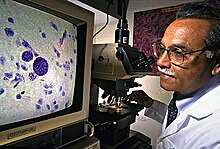Jitender P. Dubey
Jitender P. Dubey (born July 15, 1938) is a veterinary parasitologist and microbiologist who pioneered the control and diagnosis of Toxoplasma gondii (T. gondii), Neospora caninum, and Sarcocystis neurona.[1] Dubey discovered the life cycle of Toxoplasma gondii, discovered and named both Neospora caninum and Sarcocystis neurona.[2]
Early life
Dubey was born in India and received his veterinary degree in 1960, and Master in Veterinary Parasitology in 1963. In 1966, Dubey received his Ph.D. in medical microbiology from the University of Sheffield, England. From 1968-1973, he completed post doctoral training with Dr. J.K. Frenkel at the Department of Pathology and Oncology, University of Kansas Medical Center, in Kansas City.[3] Dubey has lived in Greenbelt, Maryland since 1982.[4]
Career
Jitender Dubey has spent over 30 years working for the United States Federal Government.[2] Prior to joining the U.S. Department of Agriculture in 1982, he was a professor at The Ohio State University and the University of Montana.[5][2] During his career at the USDA Agricultural Research Service Animal Parasitic Diseases Research Unit, he pioneered the identification of lifecycle and ecology of parasites, parasitic disease, and how they infect their hosts.[5][2] His work has informed farm management practices and hygienic control measures to prevent disease transmission and prevent the spread of parasitic diseases in food and livestock.[2]
Dubey is most associated with the discovery of how the parasite Toxoplasma gondii is transmitted to humans and animals through cat feces and consumption of undercooked, infected meat.[6] He discovered that Toxoplasma gondii can be carried by cats and they can release the parasite's eggs (oocysts) through their feces and causes birth defects and vision loss in humans and abortion in livestock.[6][7] His discovery lead to labels on cat litter, and informed prenatal advice against pregnant women handling cat litter because of the effects on unborn children if an egg is ingested.[7] He named the parasites Sarcocystic neruona which causes fatal neurological diseases in horses and Neospora craninum which causes cattle abortion and crippling disease in companion animals.[6]
Awards and memberships
In 2010, Dubey was inducted into the Agricultural Research Service Science Hall of Fame for his discovery that Toxoplasma gondii can be carried by cats.[7] In 2021 Dubey was named a finalist for a Samuel J. Heyman Service to America Medal.[8]
Memberships
- Member of the National Academy of Sciences since 2010.[6]
References
- ^ "Jitender Dubey : USDA ARS". www.ars.usda.gov. Retrieved 2024-01-05.
- ^ a b c d e Medals, Samuel J. Heyman Service to America. "Jitender P. Dubey". Samuel J. Heyman Service to America Medals. Retrieved 2024-01-05.
- ^ Dubey, J. P. (2021-12-07). Toxoplasmosis of Animals and Humans. CRC Press. ISBN 978-0-367-54312-9.
- ^ Arbach, Matt (August 17, 2017). "Jitender Dubey is Finalist for Service to America Medal" (PDF). Greenbelt News Review. pp. 1, 7. Retrieved April 2, 2024.
{{cite news}}: CS1 maint: url-status (link) - ^ a b Newswire, USDA. "Three Scientists Named to USDA-ARS Science Hall of Fame". Federal Newswire. Retrieved 2024-04-02.
- ^ a b c d "Jitender P. Dubey". www.nasonline.org. Retrieved 2024-04-02.
- ^ a b c "A Hall of Fame Worthy of Its Name | USDA". www.usda.gov. Retrieved 2024-04-02.
- ^ Davidson, Joe (May 8, 2017). "The "Sammies" - therapy for feds' during tough times under Trump". The Washington Post. Retrieved April 2, 2024.
{{cite news}}: CS1 maint: url-status (link)

